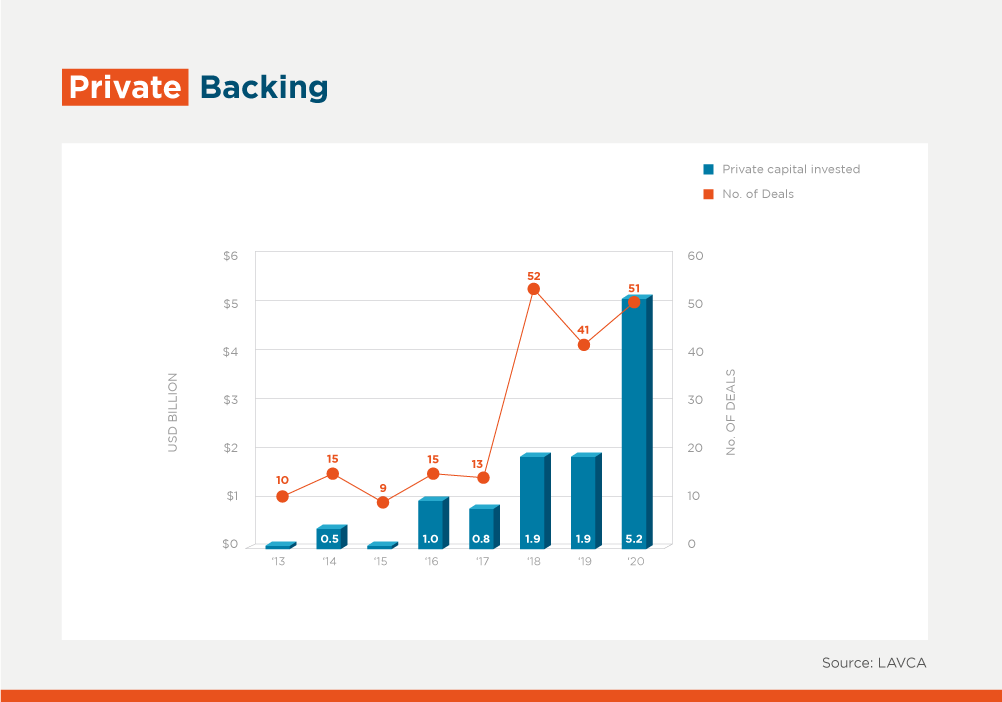The Rise of Patient Capital – Capital Markets and Private Credit in LAC

Private credit has lately experienced a surge in Latin America and the Caribbean (LAC), as so-called “patient” capital finds its way to some of the most exciting companies in the region.
LAVCA, the association for private capital investment in the region, estimates that private credit investments reached $5.2 billion through 51 deals in 2020, a record high. In 2020, private credit funds raised about $1.4 billion in six funds representing 20% of the capital raised in the region, what implies a 94.3% growth from 2019.
But, what exactly is private credit and what is the opportunity for LAC? And how does patient capital fit into this picture?

Private credit includes a very broad range of credit strategies ranging from covenant-light loans for mid-cap companies and corporates to mezzanine strategies with debt and equity features. Some people characterize private credit as tailor-made financing, in which the customization can include multiple and different combinations, including longer tenors, grace periods matched to the business cycle, and more flexible collateral requirements.
These forms of medium- and long-term customized financing can provide structured expansion funding to support well-established mid-size companies that, despite having a good business model with potential to expand, are unable to access adequate bank funding or capital markets.
LAC has seen a surge in debt strategies ranging from senior loans to mezzanine financing to mid-size companies lacking bank credit at appropriate conditions to funds investing in debentures – unsecured loan certificates – or other specialized strategies. Increasing the availability of customized private debt financing for high-growth, mid-sized companies in LAC may be an adequate way to assist firms in expanding their production capacity and improving their productivity.
Additionally, some credit funds could provide structured financial solutions that may offset the lack of access to long-term capital, by offering, for instance, mezzanine debt solutions. Mezzanine debt strategies could sit in a company’s capital structure somewhere between debt and equity and provide much needed “patient” capital without dilution.
Patient capital supports the expansion of mid-market enterprises, driving job creation and supporting the modernization of local industries – all of which is key for development and the improvement in living standards.
Moreover, private credit funds are becoming an appealing investment option for institutional investors, who have increased their appetite for alternative debt securities due to low returns from traditional fixed-income assets. In this regard, although investors may have a limited upside, vis-à-vis private equity investments, they also have downside protection as well an exit structure not depending on the whims of the market, as in the case of equity assets. All of that makes these strategies attractive from an institutional portfolio perspective.
The pandemic’s economic fallout has led some more traditional lenders to tighten corporate lending as they tend to lend conservatively in crisis situations, sometimes reducing access to credit. Against this backdrop, private credit funds present an option to reduce the lack of access to medium- and long-term lending (which has traditionally been in short supply) and provide financial solutions that are more tailored and customizable than the ones offered by commercial banks. That way, they enable companies to make the investments necessary to relaunch their businesses, support growth, and improve long-term performance.
IDB Invest has supported and promoted a range of such vehicles in the last few years by investing in regional funds, such as the Local Currency Fund II, the Microfinance Growth Fund, Kandeo 3D, Victory Park Capital, LAC Venture Debt Growth Fund and HMC Andean Private Debt; and it has also invested in local funds such as Adobe Social Mezzanine Fund I, Mezzanine Mexico Uno and Capital Indigo Private Debt in Mexico and Patria Structured Credit Fund in Brazil.
We expect to see an increase in funds with private credit strategies including hybrid solutions with capital markets components across LAC. From the investor’s perspective, this a fairly new asset class in LAC which has a great potential to generate returns with positive development impacts. For invested companies, this asset class provides expansion capital with conditions not readily available in the market: for investors, it provides an opportunity to tap into a new business at what probably are the early stages of an industry.
LIKE WHAT YOU JUST READ?
Subscribe to our mailing list to stay informed on the latest IDB Invest news, blog posts, upcoming events, and to learn more about specific areas of interest.
Subscribe



